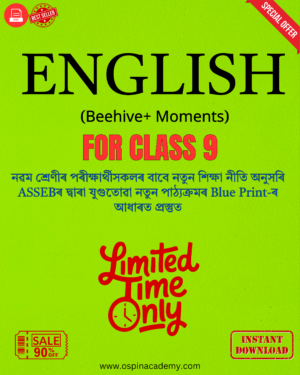SEBA Class 9 English (Beehive) Poem 2 – Wind Solutions & Summary
Looking for SEBA Class 9 English (Beehive) Poem 2 – “Wind” solutions? At Ospin Academy, you will get NCERT-based textbook answers, multiple-choice questions (MCQs), and a detailed poem summary to help you prepare for exams effectively.
📖 Poem Overview:
“Wind” by Subramania Bharati is an inspiring poem that describes the power of the wind and how it symbolizes challenges in life. The poet encourages us to be strong and determined in facing hardships.
📌 Key Themes:
- ⭐ Challenges and obstacles in life.
- ⭐ Strength, resilience, and determination.
- ⭐ The power of nature and its influence on humans.
📌 Key Concepts Covered:
- ⭐ What is the central message of the poem “Wind”?
- ⭐ How does the poet use wind as a metaphor?
- ⭐ What literary devices are used in the poem?
- ⭐ How does the poem inspire the reader?
- ⭐ What does the poet mean by “We praise him every day”?
📝 How Ospin Academy Helps:
- ✅ Exam-Oriented Solutions: Fully NCERT-based Class 9 English solutions.
- ✅ MCQs and Extra Questions: Important multiple-choice questions for better revision.
- ✅ Concept Clarity: Explanation with real-life examples.
- ✅ Quick Revision Notes: Key points summarized for last-minute preparation.
Access complete SEBA Class 9 English (Beehive) Poem 2 – “Wind” solutions at Ospin Academy and improve your understanding today!
Class 9 English (Beehive & Moments) PDF Solutions 2025-26 | SEBA Assam
Download Class 9 English (Beehive & Moments) PDF with textbook solutions, MCQs, and additional exercises for SEBA Assam 2025-26.
Chapter 2
Wind
Thinking about the Poem
I.
Question 1. What are the things the wind does in the first stanza?
Answer: The wind breaks the shutters of the windows, scatters the papers, throws down the books on the shelf, tears the pages of the books and brings the rain.
Question 2. Have you seen anybody winnow grain at home or in a paddy field? What is the word in your language for winnowing? What do people use for winnowing? (Give the words in your language, if you know them.)
Answer: Yes, I have seen my grandmother winnowing grain at home. “Fatakna” is the word in my language Hindi for ‘winnowing’. A winnowing basket is used for winnowing.
Question 3. What does the poet say the wind god winnows?
Answer: The poet says that the wind god winnows crumbling houses, doors, rafters, wood, bodies, lives and hearts and then crushes them all.
Question 4. What should we do to make friends with the wind?
Answer: To make friends with the wind, we should build strong homes and doors. We should strengthen our bodies and make the heart steadfast.
Question 5. What do the last four lines of the poem mean to you?
Answer: The last four lines give a very powerful message. They say that the wind that blows weak fires is the same wind that makes strong fires flourish.
This implies that the weak people are broken by forces but the people who are strong are strengthened by those forces. So, the friendship with the wind or a strong force is good. We have to just stay strong mentally as well as physically.
Question 6. How does the poet speak to the wind — in anger or with humor? You must also have seen or heard of the wind “crumbling lives”. What is your response to this? Is it like the poet’s?
Answer: The poet speaks to the wind with humor. He says that the wind destroys houses, doors, rafters, wood, bodies and lives. He says that it breaks the shutters of the windows and scatters the papers. But at the same time, he also points out that the wind brings rain. He tells the readers that we must become powerful and build strong houses because the wind only damages weak things.
Yes, I too have seen the wind crumbling lives on the news channels. Winds bring massive destruction sometimes. It uproots weak trees and even claims the lives of people. But as the poet says, we must try to be more powerful and build powerful structures.
II. The poem you have just read is originally in Tamil. Do you know any such poems in your language?
Answer: Yes, I have read such a poem in my language Hindi by the name “Toofan”.
SEBA Assam Class 9 English Beehive Poem 2 – Wind FAQs
Get Free NCERT PDFs
If you want to download free PDFs of any chapter, click the link below and join our WhatsApp group:

